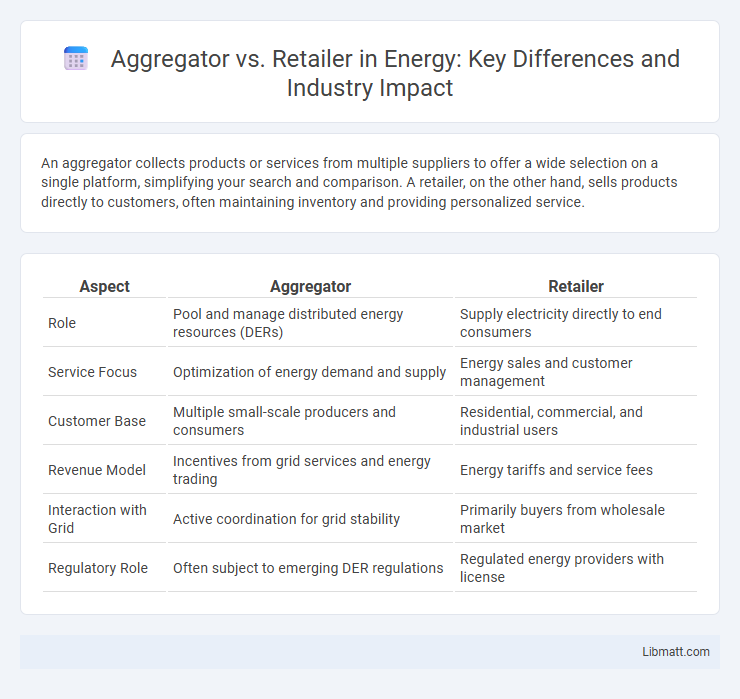An aggregator collects products or services from multiple suppliers to offer a wide selection on a single platform, simplifying your search and comparison. A retailer, on the other hand, sells products directly to customers, often maintaining inventory and providing personalized service.
Table of Comparison
| Aspect | Aggregator | Retailer |
|---|---|---|
| Role | Pool and manage distributed energy resources (DERs) | Supply electricity directly to end consumers |
| Service Focus | Optimization of energy demand and supply | Energy sales and customer management |
| Customer Base | Multiple small-scale producers and consumers | Residential, commercial, and industrial users |
| Revenue Model | Incentives from grid services and energy trading | Energy tariffs and service fees |
| Interaction with Grid | Active coordination for grid stability | Primarily buyers from wholesale market |
| Regulatory Role | Often subject to emerging DER regulations | Regulated energy providers with license |
Understanding Aggregators: Definition and Core Functions
Aggregators collect products or services from multiple retailers or providers, offering a unified platform for consumers to compare and choose. Their core functions include consolidating inventory, standardizing information, and facilitating transactions to simplify your purchasing experience. Unlike retailers who directly sell goods, aggregators act as intermediaries connecting buyers with various sellers.
What is a Retailer? Key Roles and Responsibilities
A retailer is a business or individual responsible for selling products directly to consumers, serving as the final link in the supply chain. Key roles include managing inventory, providing customer service, setting product prices, and creating an appealing shopping experience in physical stores or online platforms. Your interaction with retailers ensures convenient access to goods while benefiting from their expertise in product selection and delivery.
Aggregator vs Retailer: Business Model Comparison
Aggregators operate by collecting product or service data from multiple suppliers, presenting a unified platform that offers a wide range of choices without owning the inventory. Retailers buy and hold inventory, selling products directly to consumers, focusing on brand control and customer experience. The aggregator model emphasizes scalability and variety, while retailers prioritize product ownership and deeper customer engagement.
Revenue Streams: How Aggregators and Retailers Make Money
Aggregators generate revenue primarily through commission fees by connecting multiple sellers to a single platform, often charging a percentage of each transaction or a subscription fee from participating vendors. Retailers earn money by purchasing inventory wholesale and selling products at a markup to customers, benefiting directly from sales volume and pricing strategies. Understanding these revenue streams can help you identify the most effective business model for maximizing profitability in your market.
Customer Experience: Aggregators vs Retailers
Aggregators enhance customer experience by providing a wide range of options from multiple sources in one platform, enabling easy comparison and informed decision-making. Retailers offer personalized service and direct interaction, ensuring tailored assistance, quicker resolution of issues, and brand loyalty. The convenience of aggregators contrasts with the customized, trust-driven service of retailers, shaping distinct user engagement models.
Inventory Management: Direct vs Indirect Approaches
Aggregators use indirect inventory management by connecting multiple suppliers and retailers, aggregating their inventories into a unified platform without holding physical stock. Retailers implement direct inventory management, maintaining and controlling stock levels within their own warehouses or stores to meet customer demand swiftly. This distinction affects supply chain efficiency, response times, and inventory visibility across both business models.
Technology and Platform Integration Differences
Aggregators leverage advanced API integrations and cloud-based platforms to seamlessly connect multiple suppliers, enabling real-time inventory updates and dynamic price comparisons, while retailers primarily utilize point-of-sale systems and proprietary e-commerce platforms focused on direct customer transactions. Aggregators emphasize interoperability and scalability through microservices architecture, facilitating diverse vendor onboarding, whereas retailers concentrate on optimizing user experience and backend systems for inventory management and order fulfillment. The technological distinction lies in aggregators acting as middleware that consolidates data streams from various sources, contrasting with retailers' integrated but singular marketplace environments.
Advantages of Aggregator Models
Aggregator models offer significant advantages by consolidating multiple suppliers or service providers into a single platform, enhancing customer convenience and choice. This model leverages technology to provide real-time pricing, reviews, and availability, improving transparency and decision-making for consumers. Your ability to access diverse options quickly through an aggregator often leads to better deals and a more streamlined purchasing experience compared to traditional retailers.
Benefits of the Retailer Approach
The retailer approach offers direct control over inventory, pricing, and customer experience, enabling personalized service and consistent brand representation. Retailers build strong customer loyalty by providing tailored product selections and responsive support, enhancing overall satisfaction. Your business can achieve higher profit margins and stronger market presence through direct sales channels inherent to the retailer model.
Choosing the Right Model: Which Suits Your Business?
Choosing between an aggregator and a retailer model depends on your business goals, product control, and customer interaction preferences. Aggregators offer a platform to connect multiple sellers, emphasizing wide product variety and lower inventory risks, while retailers maintain direct ownership of inventory, ensuring full control over the product quality and customer experience. Evaluating factors such as scalability, brand identity, and operational complexity will help determine the optimal approach for your business growth.
Aggregator vs Retailer Infographic

 libmatt.com
libmatt.com